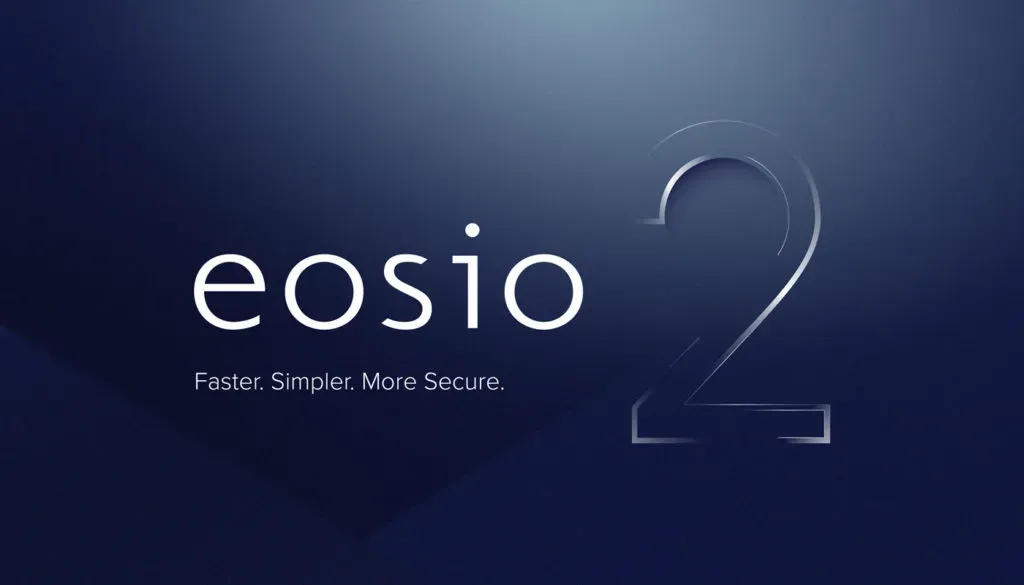EOSIO 2.0 released with developer improvements according to their blog post. EOSIO 2 was built with developers in mind, making it faster, simpler, and more secure to build on EOSIO.
The single biggest bottleneck for blockchain development is the speed in which they can execute smart contracts. EOSIO was the first blockchain software to use a WebAssembly (WASM) engine to improve performance, but in time, it outgrew existing general purpose WASM engines.
Their solution: build their own, designed from the ground up with blockchain in mind. EOS VM, the purpose-built blockchain WASM engine, runs the EOS Mechanics WASM CPU benchmarks up to 16x faster than Binaryen, which was released with EOSIO 1.0.
Next, they wanted to solve the barrier to entry for new developers – those heading to an #eosiohackathon or building on EOSIO for the first time. Typically, setting up a blockchain development environment is a multi-step process that can take hours, even days, to complete. That’s why we’re building the EOSIO Quickstart Web IDE, a development tool that allows new developers to go from start to ready-to-build in minutes.
Finally, for any developer, one of the critical pain points to onboarding new users to blockchain applications is safeguarding private and public keys, and the security risks created if done incorrectly. With this release of WebAuthn support for EOSIO, developers can begin testing transaction signing with WebAuthn in their EOSIO applications, providing a level of security for private keys that doesn’t exist in blockchain today.
Continue reading for further explanation of the four major components included in the EOSIO 2.0 Release Candidate:
EOS VM: A high-performance WebAssembly (WASM) engine specialized for blockchain applications that facilitates more efficient use of system resources when processing smart contracts and substantial performance gains.
EOSIO Quickstart Web IDE: A powerful, new, self-contained, web-based integrated development environment for building EOSIO smart contracts and associated web applications. It can be set up in minutes, run in any browser, and helps lower the barrier to entry for new EOSIO blockchain developers.
WebAuthn Support: A widely accepted secure authentication standard that enables transaction signing without browser extensions or additional software.
Weighted Threshold Multi-Signature Block Production Support: A secure way for block producers to use different keys to sign blocks on primary and backup block production hardware.
Significant Improvements to Network Code
They have added multi-threading support to net_plugin. Almost all the processing in the net_plugin, including block propagation, transaction processing, block/transaction packing/unpacking, and other processes are now handled by separate threads that are distinct from the main application thread. By isolating these processes they saw significant improvements in transaction processing and block processing performance on multi-producer EOSIO networks. More details are available in the EOSIO 2.0.0 release notes.
EOSIO Quickstart Web IDE
Enhancements in EOSIO 2 were made with developers in mind, and this new tool will make it much easier to get started, share, and collaborate on EOSIO projects.
Setting up a development environment for EOSIO currently entails a multi-step process, run locally on the developer’s computer, that may be quite complicated for those who are just onboarding. Now in the alpha support stage, the EOSIO Quickstart Web IDE intends to remove barriers to entry for developers. Run in the cloud, it enables new developers to set up a smart contract and web app development environment along with a fully integrated single-node personal testnet, so they can go from getting started to building in minutes.
The EOSIO Quickstart Web IDE makes EOSIO more accessible to new blockchain developers, simplifying the process and making it quick and easy to start learning EOSIO development. Developers can begin with demo applications, seamlessly make changes, and see updates in real-time, as well as commit code to git repositories right from the browser.
WebAuthn Support for EOSIO
WebAuthn is a standard for strong user authentication collaborated on by the World Wide Web Consortium (W3C), the Fast Identity Online (FIDO) Alliance, with help from Google, Mozilla, Microsoft, Yubico, and others. WebAuthn allows you to use a hardware device for authenticating and signing transactions in a browser without extensions or other software installed on your device.
WebAuthn creates cryptographic key pairs on devices like a YubiKey and shares only the public key with a remote server over a secure and authenticated channel. By managing authentication credentials entirely within hardware devices, WebAuthn has been shown to essentially mitigate entire classes of attacks such as phishing. Since the hardware device is essential, and passwords are not stored on a central server, implementing WebAuthn-based authentication can even help prevent high-profile data breaches where passwords are stolen.
With this release of WebAuthn support for EOSIO, developers can begin testing transaction signing with WebAuthn in their EOSIO applications. EOSIO support for WebAuthn is a step towards secure and seamless transaction signing without needing to keep track of private keys or other account information.
Weighted Threshold Multi-Signature Block Production
Block producers must be able to provide high availability for their core service of running the blockchain. A common approach to achieve this is redundant infrastructure that efficiently maintains block production in the event of a hardware malfunction or networking issues. Weighted Threshold Multi-Signature Block Production is the first of many features that seek to provide block producers with a complete, high-availability solution.
Current consensus rules require exactly one cryptographic block signing key per block producer. This key, whether stored on disk and loaded via software or protected with a hardware wallet, represents a single point of failure for the operations of a block producer. If that key is lost or access to the hardware module that contains it is temporarily unavailable, the block producer has no choice but to drop blocks, impacting the whole network’s throughput.
To improve the security and scalability of block production, weighted threshold multi-signature block support provides a permission layer that allows for multiple block signing keys in a flexible scheme that will enable redundant block signing infrastructure to exist without sharing any sensitive data. Read more about weighted threshold multi-signature block production on GitHub.



